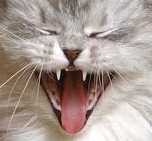Our feline friends are prone to dental disease just like we are. They have trouble with plaque, gingivitis, tartar and even periodontal disease. On top of this, most cats don’t enjoy having us try to brush their teeth.
Plaque, tartar and gingivitis
Plaque is that gummy fuzzy stuff that we also get on our teeth. It’s full of bacteria and it comes from food. We normally brush plaque away but in cats plaque gradually turns into tartar which adheres tightly to the teeth. Eventually that tartar will push up under the gum line allowing bacteria into the gum tissue which causes gingivitis.
Resorptive Lesions
Resorptive lesions are painful holes in your cat’s teeth. 70% of cats will develop these lesions in their lifetime. These holes are not cavities like people get. Cavities are soft spots in our teeth. In cats, a process in their mouth causes the tooth enamel to dissolve resulting in a hole in the tooth. The cat’s body then tries to cover the hole with abnormal gum tissue. This tissue bleeds very easily and is quite painful to the touch.
Cats hide dental disease well
Cats instinctively hide all types of pain. Many cats have dental disease and we as owners would not be able to tell. They continue to eat, play and act normal despite having dental problems which are often very painful. When cats eat they do not chew their food like we do. Instead they use their teeth like scissors to cut through muscle and bone of prey animals. Cats often don’t even use their teeth to eat the food we give to them. They are able to swallow pieces of dry food easily without chewing so they may have little discomfort despite having resorptive lesions and other dental issues.
Dental disease causes deeper problems
Gingivitis and resorptive lesions are like wounds in your cat’s mouth. These wounds allow bacteria into the bloodstream that wouldn’t normally be there. These bacteria must then be filtered by your cat’s liver and kidneys. This adds stress to these organs and their immune system.
Fixing your cat’s dental disease
The fix starts with extracting the teeth which have resorptive lesions. All feline dentistry is done under general anesthesia so your cat will not feel the procedure. Nerve blocks will be used and pain control administered so our feline friends do not wake up with mouth pain. Dental x-rays will be taken just like when we visit the dentist. Tartar and plaque are cleared away with an ultrasonic tooth scaling just like in people. Your cat’s teeth will even be polished and fluoride is used when needed. Often after dentistry is performed your cats play behavior, appetite and activity level will all improve. A healthy mouth makes kitties feel really good!
Prevention
A dental visit at your veterinarian’s office once a year is the minimum. Cats that are prone to dental disease may require more frequent dental examinations. If you are one of the lucky ones and your cat will let you brush their teeth this will help considerably. Human toothpaste can be dangerous for cats so your veterinarian will recommend a safe alternative. With or without tooth brushing however, your cat should also have a dental cleaning once to twice a year just like we do.
To schedule an appointment for a dental evaluation or cleaning click here:
http://northernilcatcliniccom.web.siteprotect.net/schedule-appointment/